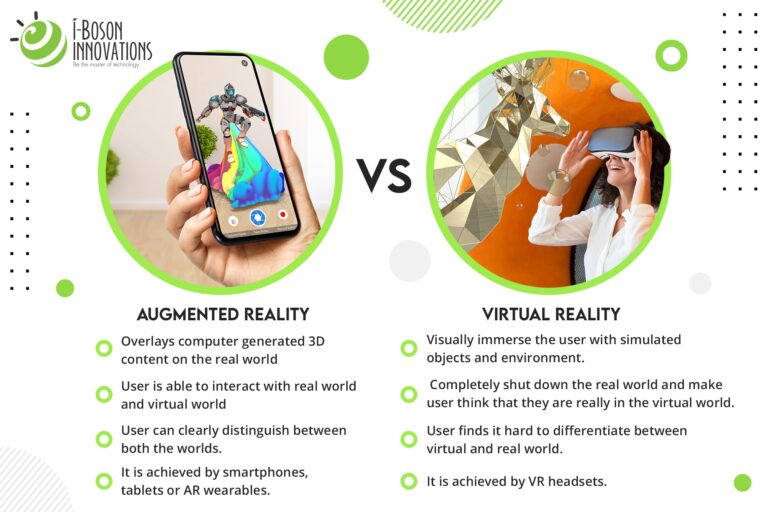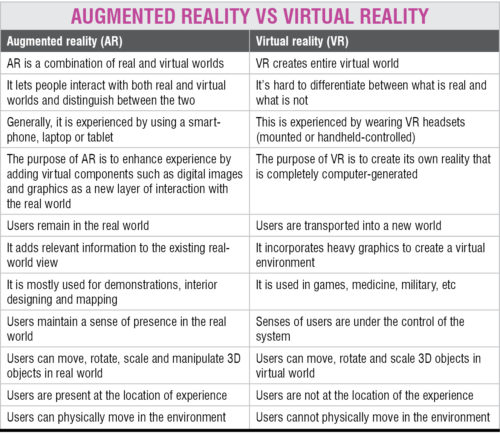Virtual Reality (VR) and Augmented Reality (AR) are two cutting-edge technologies that have revolutionized the way we experience the world around us. While both provide immersive experiences, they differ in their approach and applications. Understanding the differences between VR and AR is crucial in order to fully grasp their potential and make informed decisions about their integration into various industries.
VR takes users into a completely virtual environment, shutting out the real world and replacing it with a simulated one. It has a long history, with early concepts dating back to the 1950s. Today, VR is used in various fields, including gaming, education, and healthcare. On the other hand, AR overlays virtual elements onto the real world, enhancing our perception and interactions. AR technology has gained popularity in recent years, with applications ranging from marketing and advertising to navigation and training.

Understanding the Differences between Virtual Reality and Augmented Reality
Virtual Reality (VR) and Augmented Reality (AR) are two innovative technologies that are transforming various industries. While both VR and AR create immersive experiences for users, there are significant differences between the two. Understanding these differences is crucial for businesses and individuals looking to leverage these technologies effectively. In this article, we will explore the distinctions between VR and AR, their applications, and how they are shaping the future.
Primary keyword: Virtual Reality vs. Augmented Reality: Understanding the Differences
When it comes to Virtual Reality (VR), it refers to a simulated environment that can be similar or completely different from the real world. Users typically wear a VR headset or goggles that display a three-dimensional computer-generated environment. This technology immerses users in a completely virtual environment, blocking out the physical world around them.
On the other hand, Augmented Reality (AR) overlays digital content onto the real world, enhancing the user’s perception and interaction with their physical environment. AR is often experienced through the camera of a smartphone, tablet, or smart glasses, allowing users to see digital elements superimposed on their real surroundings.
While the end goal of both VR and AR is to enhance user experiences, they differ in how they achieve it. VR creates a fully immersive and interactive environment that isolates users from the real world, while AR seamlessly integrates digital content with the physical environment, enhancing and augmenting the real world.
In the next section, we will delve deeper into the applications and use cases of VR and AR, and explore how each technology is being utilized in various industries.
Applications and Use Cases of Virtual Reality
Virtual Reality has gained significant popularity in recent years due to its immersive capabilities and potential applications. Here are some of the key areas where VR is being utilized:
Gaming and Entertainment
One of the most well-known applications of VR is in the gaming and entertainment industry. VR gaming offers a highly immersive and interactive experience, allowing players to feel like they are part of the virtual world. The technology enables users to move around and interact with objects in the game, providing a whole new level of engagement and realism.
Furthermore, VR is also being used to create virtual tours, concerts, and other entertainment experiences. Users can virtually visit famous landmarks, attend live concerts, and explore new worlds, all from the comfort of their own homes.
Overall, Virtual Reality has revolutionized the gaming and entertainment industry by providing users with immersive, interactive, and realistic experiences.
Training and Education
Another significant application of VR is in the field of training and education. VR simulations can provide hands-on training experiences in a safe and controlled environment. From flight simulators for pilots to surgery simulations for medical professionals, VR allows individuals to gain practical experience without the risks or costs associated with real-world scenarios.
Additionally, VR is being used in education to enhance learning experiences. Students can explore historical events, visit famous landmarks, or even travel to outer space, all through VR. This technology makes learning more engaging, interactive, and immersive, ultimately improving knowledge retention.
VR has tremendous potential for training and education, offering realistic and impactful experiences that contribute to skill development and knowledge acquisition.
Design and Architecture
In the field of design and architecture, VR provides invaluable tools for visualizing and experiencing spaces before they are built. Architects and designers can use VR to create virtual walkthroughs of buildings and environments, allowing clients and stakeholders to experience the design in a realistic manner.
With VR, it becomes possible to make design adjustments in real time, improving the overall understanding and collaboration between designers, clients, and end-users. VR simulations also contribute to better decision-making and prevent costly design errors.
VR is transforming the design and architecture industry by offering immersive, interactive, and realistic experiences during the pre-construction phase.
Real Estate
Virtual Reality is also making waves in the real estate sector. VR tours allow potential buyers or renters to explore properties remotely, giving them a realistic sense of the space without physically visiting it. This technology saves time and resources for both buyers and sellers, making the property selection process more efficient.
Furthermore, VR can be used for interior design purposes, allowing users to virtually decorate and furnish a space to see how it would look before making any physical changes. This enables individuals to make informed design choices and visualize the end result.
Overall, VR is changing the way real estate transactions are conducted, providing a more immersive and efficient experience for buyers, sellers, and real estate professionals.
Applications and Use Cases of Augmented Reality
Augmented Reality has also gained significant traction across various industries. Let’s explore the applications and use cases of AR:
Retail and E-commerce
AR is revolutionizing the retail and e-commerce landscape. With AR, customers can virtually try on clothing, accessories, or cosmetics before making a purchase. AR applications allow users to see themselves wearing different items, providing a more realistic shopping experience and reducing the likelihood of returns.
Furthermore, AR can be used to overlay product information, specifications, or customer reviews onto physical products. This enhances the shopping experience, allowing customers to make more informed purchasing decisions.
AR is reshaping the retail industry, offering innovative solutions to engage customers and improve the overall shopping experience.
Healthcare
In the healthcare sector, AR has a wide range of applications. Surgeons can use AR to superimpose digital imaging data onto the patient’s body during surgical procedures, providing real-time guidance and enhancing precision. This technology improves surgical outcomes and reduces the risk of complications.
AR is also being used for medical training, where students can visualize and practice complex procedures in a hands-on virtual environment. Additionally, AR can assist in patient diagnosis by overlaying medical images or data onto the patient, aiding in the interpretation of results.
The healthcare industry has embraced AR to improve patient care, enhance surgical procedures, and provide better training opportunities for medical professionals.
Manufacturing and Maintenance
AR is also transforming the manufacturing and maintenance sectors. In manufacturing, AR can provide real-time instructions, overlays, or visual aids to guide workers through complex assembly processes, reducing errors and improving efficiency.
For maintenance and repairs, AR can superimpose step-by-step instructions, diagrams, or animations onto equipment or machinery, simplifying troubleshooting and enhancing the accuracy of repairs.
By leveraging AR, manufacturing companies can streamline production processes and improve maintenance workflows, leading to increased productivity and cost savings.
Gaming and Entertainment
AR is not just limited to retail, as it has also made significant advancements in the gaming and entertainment industry. Pokemon Go, an AR-based mobile game, became a global phenomenon, allowing users to capture virtual creatures in the real world using their smartphones.
In addition to gaming, AR is being used in the entertainment sector to enhance live events, concerts, and performances. Augmented reality elements can be projected onto stages, creating captivating visual experiences for the audience.
AR has added a new dimension to gaming and entertainment, merging the virtual world with the real world to create unique and engaging experiences.
Conclusion
Virtual Reality (VR) and Augmented Reality (AR) offer incredible opportunities for various industries and sectors. While VR provides an immersive, isolated, and interactive virtual environment, AR overlays digital content onto the real world, enhancing and augmenting the user’s physical environment. Both technologies have unique applications and use cases, revolutionizing industries such as gaming, entertainment, training, retail, healthcare, and more.
As technology continues to advance, VR and AR will continue to shape the future of how we engage with digital content and interact with the world around us. By understanding the differences between VR and AR and exploring their applications, businesses and individuals can harness the potential of these technologies to enhance user experiences, improve productivity, and drive innovation.
This table provides a summary of the differences between Virtual Reality and Augmented Reality:| Virtual Reality (VR) | Augmented Reality (AR) |
|---|---|
| Creates a fully immersive and isolated virtual environment. | Overlays digital content onto the real world, enhancing the physical environment. |
| Uses a headset or goggles to block out the physical world. | Utilizes devices such as smartphones or smart glasses to overlay digital elements onto the real world. |
| Applications include gaming, training, education, design, and real estate. | Applications include retail, healthcare, manufacturing, and entertainment. |
Key Takeaways
- Virtual reality (VR) is an immersive experience that completely transports the user to a virtual world.
- Augmented reality (AR) overlays digital information onto the real world, enhancing the user’s perception of reality.
- VR requires specialized headsets, while AR can be experienced through smartphones or smart glasses.
- VR is commonly used in gaming and entertainment, while AR has applications in fields like education, healthcare, and industrial training.
- Both VR and AR offer unique experiences and have the potential to revolutionize various industries.

Virtual Reality (VR) and Augmented Reality (AR) are two different technologies that enhance our perception of the world, but they have distinct differences.
VR creates a completely immersive experience by transporting users to a simulated environment, while AR overlays digital content onto the real world. VR is like being inside a video game, while AR is like having information displayed through a transparent screen. Both have their own exciting possibilities and applications, such as VR for gaming and training simulations, and AR for education and real-time data visualization.


